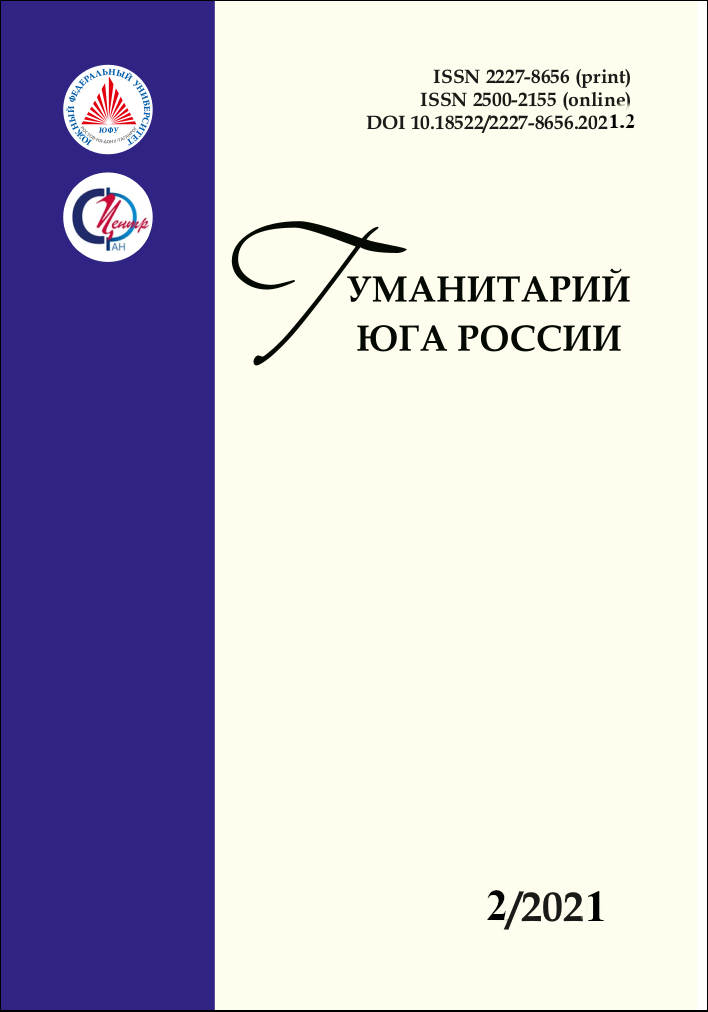Fabbing as an Indefinite Phenomenon in the Structure of Social Deviantology
Research Article
How to Cite
Grigoryev N.Y., Chvyakin V.A. Fabbing as an Indefinite Phenomenon in the Structure of Social Deviantology. Humanities of the South of Russia. 2021. Vol. 10. No. 2. P. 27-37. DOI: https://doi.org/10.18522/2227-8656.2021.2.2 (in Russ.).
Abstract
Objective of the study is to identify the significance of fabbing as an indefinite phenomenon in the structure of social deviantology.
The methodological basis of the study is the general theory of social communication, taking into account the behavioral approach in assessing fabbing (V. Chotpitayasunondh, K. Douglas, J.A. Finkel, D.J. Kruger), as well as the principles of regulating structural models of fabbing in interpersonal communication (A. Guazzini, M. Duradoni, A. Capelli, P. Meringolo, M. Beranuy, U. Oberst, X. Carbonell, A. Chamarro, K. Kircaburun, and others).
Research results. Fabbing has negative consequences for interpersonal communication, which can include:
- reduced level of relationship satisfaction;
- conflict in the process of interpersonal communication;
- weakening of group cohesion;
- the emergence of a sense of social isolation (loneliness in the group);
- reduced level of empathy and trust in interpersonal relationships;
- deterioration of the assimilation of useful information.
Fabbing can be attributed to the problems of social deviantology, since:
- is a widespread phenomenon;
- characterized by internal inconsistency;
- it is related to the interests of large social groups.
The prospects of the study suggest:
- development of measures to minimize the negative consequences of fabbing by structuring the culture of interpersonal communication and business communications;
- identification of positive characteristics of fabbing, which reflect the need to maintain a high level of business activity of subjects of social communication.
Keywords:
social communication, social deviantology, fabbing, structure of fabbing, causes of fabbing, satisfaction with communication, negative consequences of fabbing
References
Goffman, E. (2009). Ritual of interaction: Essays on behavior face to face. Transl. from English; N.N. Bogomolova, D.A. Leontyev (Eds.). M.: Smysl. (in Russian).
Chvyakin, V.A., Grigoryev, N.Yu. (2020). Fabbing in the structure of social communications: a sociological analysis of the phenomenon. Gumanitariy Yuga Rossii, 9, 5, 150-161. DOI: https://doi.org/10.18522/2227-8656.2020. 5.12. (in Russian).
Abramova, O., Baumann, A., Krasnova, H., Lessmann, S. (2017). To Phub or not to Phub: Understanding Off-Task Smartphone Usage and Its Consequences in the Academic Environment.
Bauminger, N. (2010). Jealousy in autism spectrum disorders (ASD). Handbook of jealousy: Theory, research, and multidisciplinary approaches, 267-292.
Hiniker, A., Schoenebeck, S.Y., Kientz, J.A. (2016). Not at the Dinner Table: Parents’ and Children’s Perspectives on Family Technology Rules. CSCW 16, February 27 - March2, San Francisco, CA, USA.
Karadağ, E., Tosuntaş, Ş.B., Erzen, E., Duru, P., Bostan, N., Şahin, B.M., Çulha, İ., Babadağ, B. (2015). Determinants of phubbing, which is the sum of many virtual addictions: A structural equation model. Journal of Behavioral Addictions, 4 (2), 60-74.
Krasnova, H., Abramova, O., Notter, I., Baumann, A. (2016). Why Phubbing is Toxic for Your Relationship: Understanding the Role of Smartphone Jealousy among “Generation Y” Users. Twenty-Fourth European Conference on Information Systems (ECIS), İstanbul, Turkey.
Radesky, J.S., Kistin, C.J., Zuckerman, B., Nitzberg, K., Gross, J., Kaplan-Sanoff, M., Augustyn, M., Silverstein, M. (2014). Patterns of mobile device use by caregivers and children during meals in fast food restaurants. Pediatrics, 133 (4), 843-849.
Roberts, J.A., David, M.E. (2016). My life has become a major distraction from my cell phone: partner phubbing and relationship satisfaction among romantic partners. Computers in Human Behavior, 54, 134-141.
Chvyakin, V.A., Grigoryev, N.Yu. (2020). Fabbing in the structure of social communications: a sociological analysis of the phenomenon. Gumanitariy Yuga Rossii, 9, 5, 150-161. DOI: https://doi.org/10.18522/2227-8656.2020. 5.12. (in Russian).
Abramova, O., Baumann, A., Krasnova, H., Lessmann, S. (2017). To Phub or not to Phub: Understanding Off-Task Smartphone Usage and Its Consequences in the Academic Environment.
Bauminger, N. (2010). Jealousy in autism spectrum disorders (ASD). Handbook of jealousy: Theory, research, and multidisciplinary approaches, 267-292.
Hiniker, A., Schoenebeck, S.Y., Kientz, J.A. (2016). Not at the Dinner Table: Parents’ and Children’s Perspectives on Family Technology Rules. CSCW 16, February 27 - March2, San Francisco, CA, USA.
Karadağ, E., Tosuntaş, Ş.B., Erzen, E., Duru, P., Bostan, N., Şahin, B.M., Çulha, İ., Babadağ, B. (2015). Determinants of phubbing, which is the sum of many virtual addictions: A structural equation model. Journal of Behavioral Addictions, 4 (2), 60-74.
Krasnova, H., Abramova, O., Notter, I., Baumann, A. (2016). Why Phubbing is Toxic for Your Relationship: Understanding the Role of Smartphone Jealousy among “Generation Y” Users. Twenty-Fourth European Conference on Information Systems (ECIS), İstanbul, Turkey.
Radesky, J.S., Kistin, C.J., Zuckerman, B., Nitzberg, K., Gross, J., Kaplan-Sanoff, M., Augustyn, M., Silverstein, M. (2014). Patterns of mobile device use by caregivers and children during meals in fast food restaurants. Pediatrics, 133 (4), 843-849.
Roberts, J.A., David, M.E. (2016). My life has become a major distraction from my cell phone: partner phubbing and relationship satisfaction among romantic partners. Computers in Human Behavior, 54, 134-141.
Article
Received: 15.02.2021
Accepted: 28.04.2021
Citation Formats
Other cite formats:
APA
Grigoryev, N. Y., & Chvyakin, V. A. (2021). Fabbing as an Indefinite Phenomenon in the Structure of Social Deviantology. Humanities of the South of Russia, 10(2), 27-37. https://doi.org/10.18522/2227-8656.2021.2.2
Section
SOCIAL STRUCTURE AND SOCIAL INSTITUTIONS IN MODERN SOCIETY






